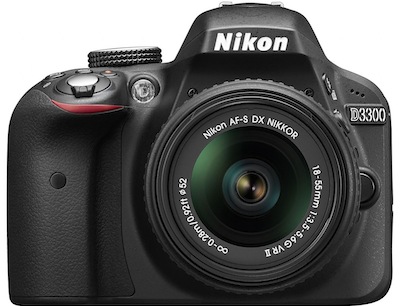Nikon D3300 Updates Popular Entry-Level DSLR
Nikon's latest tech comes to its popular line of beginner DSLRs, along with a retracting lens that makes the whole package 35 percent smaller.


Many photographers, be they pros or hacks, can trace their picture taking back to a single influential SLR camera. In film days, it was often the Pentax K1000. In the digital age, it's often been a Canon Digital Rebel or Nikon D3000 series camera.
That's why Nikon's new D3300 will probably mean more to casual photographers than the other camera news coming out of the 2014 Consumer Electronics Show. Nikon will begin selling the new camera on Feb. 20, with an 18-55mm, f/3.5-5.6 kit lens for $649.95.
MORE: 14 Best Photo Editing Apps of 2013
You won't see much difference in the camera body, as it's about the same size and shape, offered in black, red or gray as in the past. But you will see a big change in the new 3X (18-55mm)zoom kit lens, a collapsible model that retracts, antenna style when not in use. (The lens shortens its barrel, but does not retract into the camera body itself.) This makes the D3300 35 percent smaller and 25 percent lighter, says Nikon. This may not be as dramatic on a DSLR as on a slimmer mirrorless camera like the new Samsung NX30 or Nikon's own Nikon One line. But by the same logic, any effort to trim a bulky DLSR will be welcome.
Otherwise, the lens carries the same specs as its predecessor, including the all-important optical image stabilization (which Nikon calls Vibration Reduction, or VR).
Better quality promised
The number many people look at first, megapixels, remains at a generous 20.4. But actual image resolution may be better because of several changes Nikon has made inside. For starters, it removed the optical low-pass filter that used to sit over the image sensor. An OLPF is meant to reduce moiré, the wavy lines that appear when a pattern you are shooting, such as pinstripes, aligns too closely with the rows and columns of the pixels on the sensor.

The OLPF blurs the image slightly to hide moiré. But having a sensor of such high resolution, Nikon found that moiré was either gone or too small to notice, so it removed the filter, allowing the sensor to capture more-detailed images. Nikon has been rolling this change down the line, with its D7100 and D5300 and now in the entry-level D3300.
Sign up to get the BEST of Tom's Guide direct to your inbox.
Get instant access to breaking news, the hottest reviews, great deals and helpful tips.
Another change that might improve image detail: By upgrading the camera processor from its Expeed 3 to Expeed 4 chip, Nikon has upped the highest light sensitivity from the ISO 12,800 to ISO 25,600. To put that in perspective, the camera can see far better in the dark than you can. The highest ISO settings will most likely be pretty grainy (we haven’t had a chance to try the camera yet). But lower ISOs, such as the ISO 1600 or ISO 3200 you often need indoors, should be less grainy than with the older processor.
MORE: Best DSLRs
The new processor also speeds up shooting from a maximum of 4 frames per second to 5fps — a notable improvement for capturing action such as sports (be it pro or peewee). That should be noticeably faster than Canon's EOS Rebel T3i, a camera that, while long of tooth, competes at the same price point. (The newer, and more similarly equipped T5i is listed at a whopping $850.)
Video capability also gets a boost. The D3300 can shoot 1080p video at up to 60 frames per second (as well as at 24 and 30fps). That beats the max 30fps of similarly priced cameras from Canon and Samsung and matches what Sony can do in this price range.
A welcome upgrade for many: Nikon has introduced with the D3300 its "easy panorama mode," which allows you to capture a panoramic photo by simply sweeping the camera across a scene. Sony brought a similar feature to its DLSRs several years ago, and it's now even a common feature on smartphones. Nikon has finally joined the party.
As for the D3200, Nikon representatives told Tom's Guide that it is "not being discontinued," although they clarified that Nikon is not making any more. Essentially, Nikon and retailers will sell the camera until stocks run out. Look for discounts on this still very capable starter camera. (Nikon had dropped the price on its site by $100 even more announcing the D3300.)
New prime lens

Switching from beginner to high-end, Nikon also introduced a new prime (that is, non-zoom) lens, the AF-S NIKKOR 35mm f/1.8G. Prime lenses are popular with photographers because they are simpler and tend to offer better quality, dollar-for-dollar, then zooms. They also offer much larger apertures (making them "fast" lenses in photo parlance, since they allow in enough light to enable much faster shutter speeds without the images coming out dark).
At 35mm, the new lens is well-suited to portraits, especially because the wide, f/1.8 aperture allows the photographer to artfully blur out the background and keep the focus on the subject's face. Also available Feb. 20, the lens will list for $599.95
Follow Sean Captain @seancaptain and on Google+. Follow us @tomsguide, on Facebook and on Google+.
Sean Captain is a freelance technology and science writer, editor and photographer. At Tom's Guide, he has reviewed cameras, including most of Sony's Alpha A6000-series mirrorless cameras, as well as other photography-related content. He has also written for Fast Company, The New York Times, The Wall Street Journal, and Wired.
